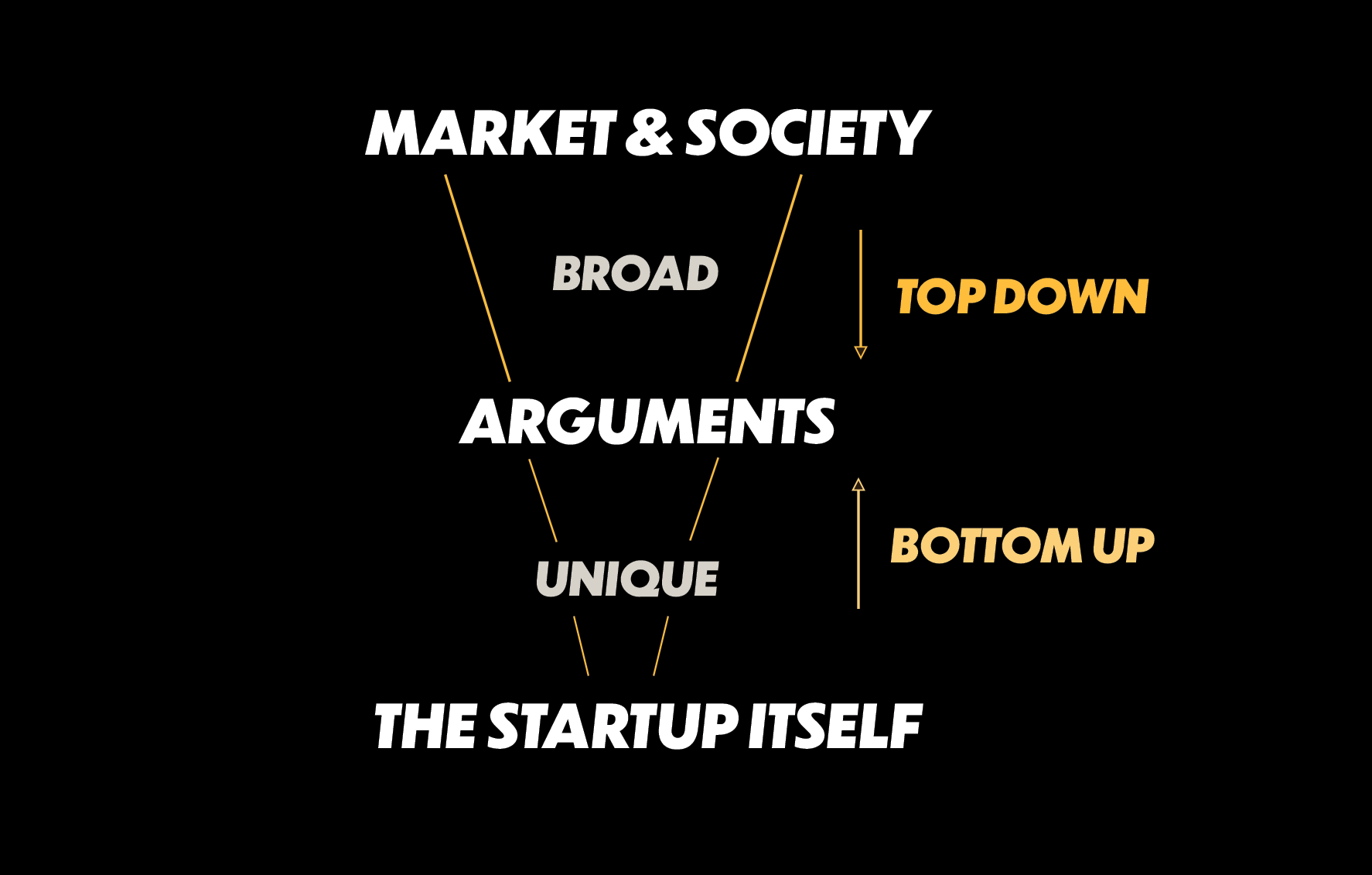Imagine you are sitting in the audience at a pitch competition.
Table of Contents
This curly-haired dude shuffles on stage. Behind him is a slide with a picture of the greenest grass you’ve ever seen.

“Hello, My name is Schmeroen Zoelen. I’m introducing The lawnmower-toaster”
A picture of the most peculiar contraption pops on the screen. The audience giggles a little.

Some person in the back lets out a slightly too loud: “What the hell?”. The audience giggles again.
The pitcher goes on like nothing happened: “Save time while mowing your lawn. It adapts heat from the engine to toast bread. No longer you are waiting for a snack while mowing your lawn. Win-Win! We sell our product for €599”
He flicks on the next slide.

- “Time saving & productivity is a key trend according to OECD
- People want to go back to basics & nature without compromise
- The gardening market is a $100B market worldwide
- Power tool market is growing to $38B by 2024”
He ends his pitch: “Want to invest? Hit me up! Slide into my DMs”
Hesitant applause rolls over the room.
Are you convinced?
I’m not. It’s not that his claims are untrue.
Actually, I did my homework: for each of these claims, I’ve got a (somewhat reputable) source.
Claims for the lawnmower-toaster
- The gardening market is a $100B market worldwide (source)
- The power tool market is growing to $38B by 2024 (source)
- Time saving & productivity is a key trend according to OECD (source)
- People want to go back to basics & nature without compromise (source)
So it’s not that the claims are untrue. But I’m not convinced.
I can easily cook up similar arguments against it. Here:
Why not:
- Fewer and fewer people are having gardens due to the housing crisis and urbanisation (source)
- There’s a trend in outsourcing gardening work to gig workers as gardeners are increasing their revenues (source)
- Millennials are all about the renting economy, not buying stuff (source)
So in a similar way, I’ve given you three arguments against this idea. Now we don’t know where we stand.
Well we do, the product is weird as hell. That’s not my point.
What all of the above arguments have in common is that they are what I call top-down arguments. I see them too often. Let’s dive into that.
Top-down and bottom-up arguments
In general, most arguments aim to convince of the potential and relevance of a startup.
I identify two types of arguments: top-down and bottom-up.

Top-down arguments
This type of argument I like to call top-down. They likely are unlinked to your startup. They might be relevant, but not uniquely so.
Top-down arguments have their role. They are best for showing the opportunity size of a startup. They also work well for arguments on timing, the ‘why now’ arguments. For instance, when a new regulation is coming up that your startup helps to address.
Examples
“This market is growing by 25% each year”
“There’s a trend of people doing X”
“Y is a core human need”
“From 2025, companies need to be compliant to Z”
Characteristics of top-down arguments
- Broad and abstract
- Not directly linked to your startup
- These arguments go for anyone in your market
Tips
- These arguments go well for opportunity size and timing arguments
- It’s okay to have them, just be aware that they are on their own not enough
- It shows you’ve done your desk research homework, yet doesn’t guarantee a home run.
Bottom-up
I always look for bottom-up & linked arguments. These are unique to the startup and contain real evidence. It’s much harder to generate this type of argument.
They might feel smaller or of less potential than the broader market sizing arguments. However, these are the stepping stones to capturing that market.
Examples
“Out of 20 people we interviewed, 18 said they have issues with Y”
“We’ve raised €500k”
“People that used our product report benefit X,Y, and Z”
“We’ve partnered with 10 suppliers”
“In the past 3 months, we’ve grown 10% per month”
Characteristics of bottom-up arguments
- Unique for your startup
- Hard to copy by others
- They showcase your results, progress and intentions
Tips
- Bottom-up is the proof in the eating of the pudding
- These types of arguments work well for showing that YOU can do it
- Most (first-time) founders have issues with recognising their bottom-up arguments
- The lack of bottom-up arguments is a red flag for lack of progress toward PM-fit
Sizing and eating that pie
Top-down arguments work great for opportunity sizing. You can show how big the pie is you want to take a bite out of. That’s great. You can make arguments about why you should act now, such as a regulation coming up that you can mitigate. These go for anyone in the market.
However, you need to show that you are eating that pie. Our pitcher from the opening anecdote didn’t show you anything on this aspect.
You need not only a plan on how to eat that pie but you should show you are eating that pie. Schmeroen Zoelen provided neither.
This is where bottom-up arguments come in. Amount of customers, people on waiting lists, and suppliers partnered: all about your progress in realising your business model.
What’s the right balance?
I inquired with my friend Viki, he’s a pitch coach and helped many startups pitch and raise capital. His view is that the further you are, the more bottom-up arguments you should have. It’s expected by investors.
“Bottom-up arguments often signal certain maturity of a business and its founders” – Viki (Follow him on Twitter)

Homework
- Get your last pitch deck or verbal pitch outline.
- Count all arguments and mark them top-down or bottom-up
- Reflect on the balance









